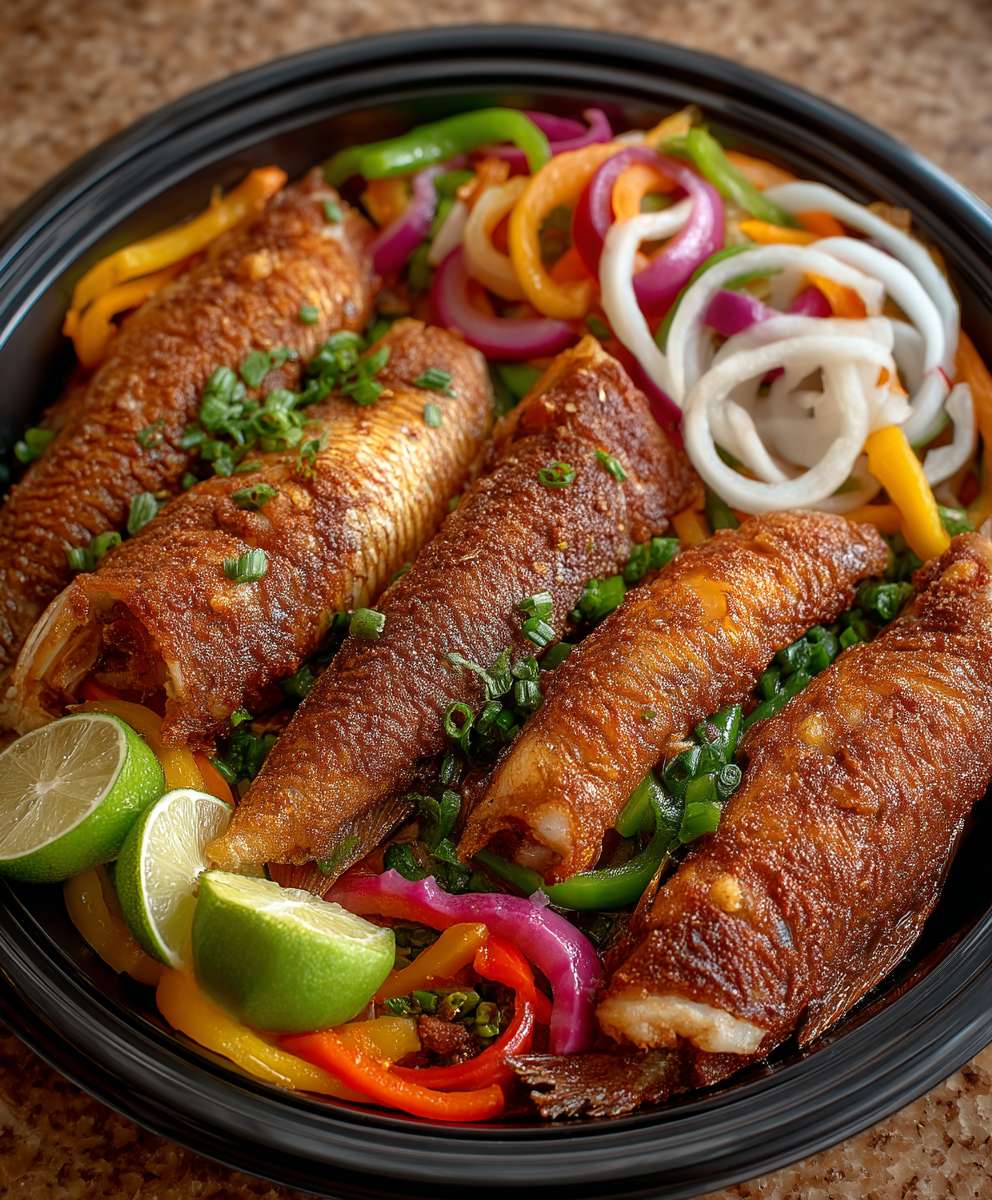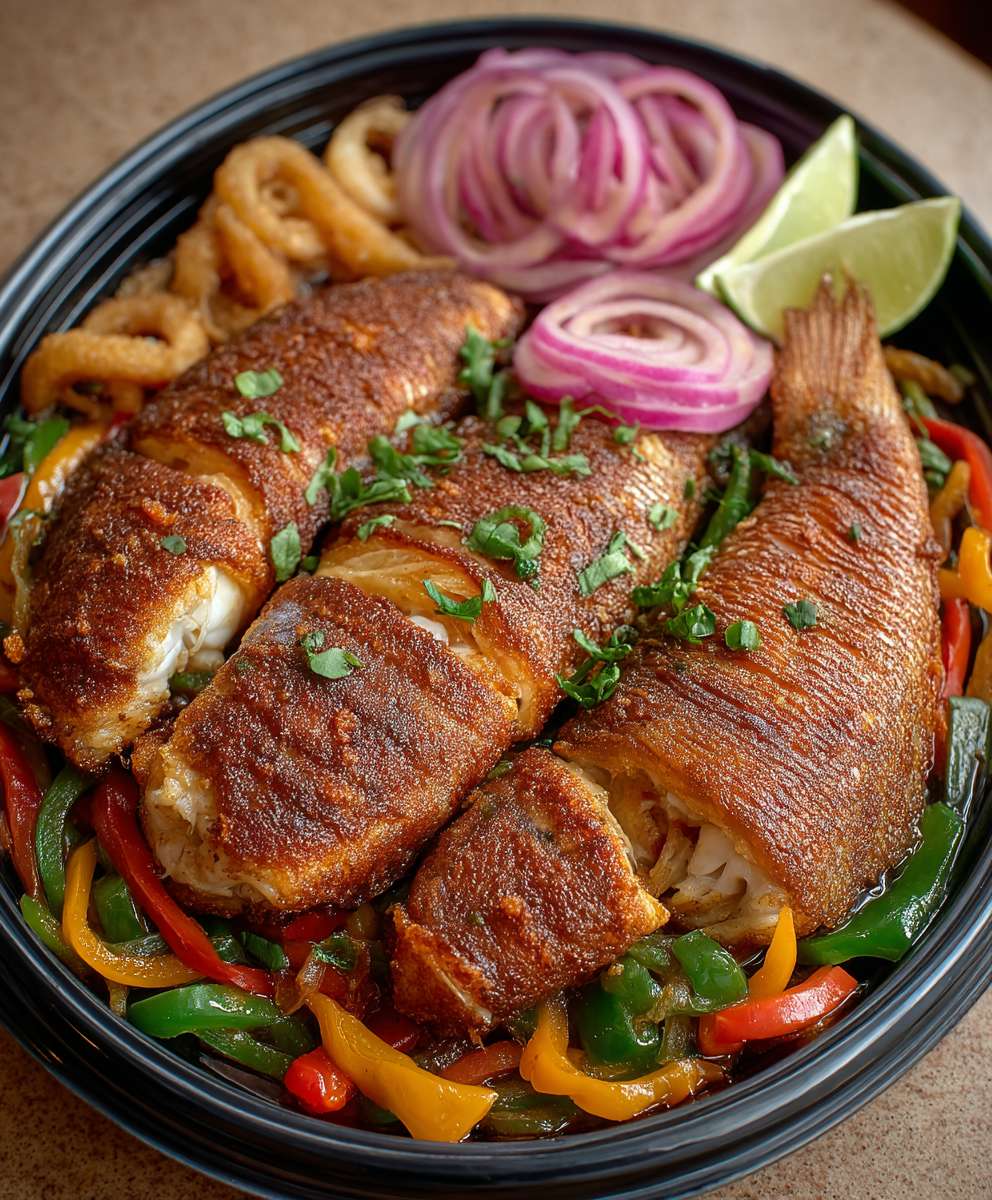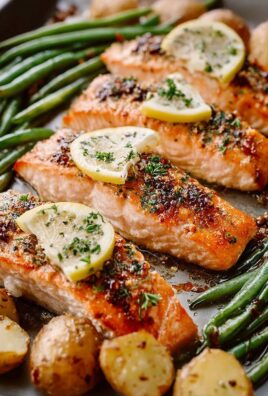Escovitch Fish Caribbean Fried is a vibrant and flavorful dish that will transport your taste buds straight to the sunny shores of the Caribbean! Imagine biting into crispy, golden-brown fried fish, its delicate flesh infused with a tangy, spicy, and slightly sweet marinade. This isn’t just fried fish; it’s an experience, a celebration of Caribbean culinary heritage.
Escovitch, derived from the Spanish word “escabeche,” refers to a method of pickling or marinating food in vinegar, spices, and vegetables. This technique arrived in the Caribbean centuries ago and evolved into the unique and beloved dish we know today. Each island boasts its own variation, but the core elements of fried fish smothered in a colorful, piquant sauce remain constant. It’s a dish often enjoyed during special occasions, family gatherings, and especially during Easter celebrations.
What makes Escovitch Fish Caribbean Fried so irresistible? It’s the perfect marriage of textures and tastes. The crispy, perfectly fried fish provides a satisfying crunch, while the escovitch sauce, brimming with scotch bonnet peppers (use sparingly!), onions, carrots, and pimento seeds, delivers a delightful explosion of sweet, sour, and spicy notes. It’s a dish that’s both comforting and exciting, a true testament to the ingenuity and vibrancy of Caribbean cuisine. Plus, it’s surprisingly easy to make at home, allowing you to bring a taste of the islands to your own kitchen!
Ingredients:
- For the Fish:
- 2 lbs whole red snapper (or other firm white fish), scaled and gutted
- 1 tbsp all-purpose seasoning
- 1 tsp salt
- 1/2 tsp black pepper
- 1/4 tsp cayenne pepper (optional, for extra heat)
- 1/4 cup all-purpose flour
- 1/4 cup cornstarch
- Vegetable oil, for frying (enough to submerge the fish)
- For the Escovitch Sauce:
- 1 large onion, thinly sliced
- 1 bell pepper (any color), thinly sliced
- 1 scotch bonnet pepper, seeded and thinly sliced (use caution!)
- 4 cloves garlic, minced
- 1 cup white vinegar
- 1/2 cup water
- 1/4 cup brown sugar
- 2 tbsp pimento seeds (allspice berries), crushed
- 1 tbsp pickling spice
- 1 tsp salt
- 1/2 tsp black pepper
- 1/4 cup vegetable oil
- 2 sprigs fresh thyme
- 2 bay leaves
- 1 carrot, julienned (optional)
Preparing the Fish:
- Clean and Prepare the Fish: Rinse the red snapper thoroughly under cold water. Pat it dry with paper towels, inside and out. Make shallow diagonal cuts on both sides of the fish; this helps the fish cook evenly and allows the flavors to penetrate.
- Season the Fish: In a small bowl, combine the all-purpose seasoning, salt, black pepper, and cayenne pepper (if using). Rub this mixture all over the fish, ensuring it gets into the cuts you made. Let the fish marinate for at least 30 minutes, or up to an hour, in the refrigerator. This allows the flavors to meld and the fish to absorb the seasoning.
- Prepare the Dredge: In a shallow dish, whisk together the all-purpose flour and cornstarch. The cornstarch helps create a crispier crust.
- Dredge the Fish: Dredge each fish in the flour mixture, making sure to coat it evenly on all sides. Shake off any excess flour. This will help create a beautiful golden-brown crust when frying.
Frying the Fish:
- Heat the Oil: Pour enough vegetable oil into a large, deep skillet or pot to submerge the fish. Heat the oil over medium-high heat until it reaches a temperature of 350-375°F (175-190°C). You can test the oil by dropping a small piece of bread into it; if it sizzles and turns golden brown in about 30 seconds, the oil is ready. Be careful not to overheat the oil, as it can burn the fish.
- Fry the Fish: Carefully place the fish into the hot oil, one at a time, being careful not to overcrowd the pan. Overcrowding will lower the oil temperature and result in soggy fish. Fry for about 6-8 minutes per side, or until the fish is golden brown and cooked through. The internal temperature of the fish should reach 145°F (63°C).
- Remove and Drain: Use a slotted spoon or spatula to carefully remove the fish from the oil. Place it on a wire rack lined with paper towels to drain off any excess oil. This will help keep the fish crispy.
Preparing the Escovitch Sauce:
- Prepare the Vegetables: Thinly slice the onion and bell pepper. Seed and thinly slice the scotch bonnet pepper (use gloves and extreme caution when handling scotch bonnet peppers, as they are very hot!). Mince the garlic. If using, julienne the carrot.
- Sauté the Vegetables: Heat the vegetable oil in a large skillet or pot over medium heat. Add the sliced onion and bell pepper and sauté until softened, about 5-7 minutes.
- Add Aromatics: Add the minced garlic and scotch bonnet pepper (if using) to the skillet and sauté for another minute, until fragrant. Be careful not to burn the garlic.
- Combine the Sauce Ingredients: Pour in the white vinegar and water. Add the brown sugar, crushed pimento seeds, pickling spice, salt, black pepper, thyme sprigs, bay leaves, and julienned carrots (if using).
- Simmer the Sauce: Bring the sauce to a simmer, then reduce the heat to low and let it simmer for at least 15-20 minutes, or until the vegetables are tender and the sauce has thickened slightly. The longer it simmers, the more the flavors will meld together. Taste and adjust the seasoning as needed. You may want to add a little more brown sugar for sweetness or vinegar for tanginess.
- Remove Thyme and Bay Leaves: Before serving, remove the thyme sprigs and bay leaves from the sauce.
Assembling the Escovitch Fish:
- Pour the Sauce Over the Fish: Place the fried fish on a serving platter. Generously pour the hot escovitch sauce over the fish, making sure to cover it completely.
- Marinate (Optional): For the best flavor, allow the fish to marinate in the sauce for at least 30 minutes before serving. This allows the flavors to penetrate the fish and creates a truly authentic escovitch experience. You can even refrigerate it overnight for an even more intense flavor.
- Serve: Serve the escovitch fish hot or at room temperature. It’s traditionally served with bammy (cassava flatbread), festival (sweet fried dumplings), or rice and peas.
Tips for the Best Escovitch Fish:
- Use Fresh Ingredients: The fresher the ingredients, the better the flavor of your escovitch fish.
- Don’t Overcrowd the Pan: When frying the fish, make sure not to overcrowd the pan. This will lower the oil temperature and result in soggy fish. Fry the fish in batches if necessary.
- Adjust the Heat: Scotch bonnet peppers are very hot, so adjust the amount to your liking. If you’re sensitive to spice, you can omit them altogether or use a milder pepper.
- Marinate for Flavor: Allowing the fish to marinate in the escovitch sauce is key to developing the authentic flavor of this dish. The longer it marinates, the better it will taste.
- Experiment with Vegetables: Feel free to add other vegetables to the escovitch sauce, such as sliced carrots, okra, or chayote squash.
- Use the Right Fish: While red snapper is traditional, other firm white fish like grouper, kingfish, or even tilapia can be used. Just make sure the fish is fresh and firm.
- Control the Sweetness: The amount of brown sugar can be adjusted to your preference. Some people prefer a sweeter escovitch, while others prefer a more tangy flavor. Start with the recommended amount and add more to taste.
- Don’t Skip the Pimento Seeds: Pimento seeds (allspice berries) are a key ingredient in escovitch sauce and add a unique flavor. Don’t skip them! If you can’t find whole pimento seeds, you can use ground allspice, but the flavor won’t be quite the same.
Serving Suggestions:
- Bammy: A traditional Jamaican flatbread made from cassava.
- Festival: Sweet fried dumplings that are a perfect complement to the savory fish.
- Rice and Peas: A classic Caribbean side dish made with rice, coconut milk, and kidney beans (or gungo peas).
- Coleslaw: A refreshing coleslaw can help balance the richness of the fried fish and the tanginess of the escovitch sauce.
- Fried Plantains: Sweet and caramelized fried plantains are another delicious side dish that pairs well with escovitch fish.
Storage Instructions:
- Refrigerate: Leftover escovitch fish can be stored in an airtight container in the refrigerator for up to 3 days.
- Reheating: Reheat the fish in the oven at 350°F (175°C) until warmed through. You can also reheat it in a skillet over medium heat. Be careful not to overcook the fish, as it can become dry.
- Freezing: While you can freeze escovitch fish, the texture of the fish may change slightly after thawing. If you do freeze it, wrap it

Conclusion:
So there you have it! This Escovitch Fish recipe is more than just a meal; it’s a vibrant journey to the heart of the Caribbean, right in your own kitchen. I truly believe this is a must-try recipe for anyone looking to add a burst of flavor and a touch of sunshine to their dining table. The combination of crispy, perfectly fried fish and the tangy, spicy, and slightly sweet escovitch sauce is simply irresistible. It’s a dish that’s both comforting and exciting, familiar yet refreshingly different.
Why is this Escovitch Fish a must-try? Because it’s an explosion of textures and tastes that will tantalize your taste buds. The crispy exterior of the fish gives way to a flaky, tender interior, while the escovitch sauce provides a delightful contrast with its crunchy vegetables and zesty marinade. It’s a complete sensory experience! Plus, it’s surprisingly easy to make, even for beginner cooks. Don’t let the fancy name intimidate you; the steps are straightforward, and the results are spectacular.
But the best part? It’s incredibly versatile! While I love serving this Escovitch Fish with a side of fluffy rice and peas (a Caribbean staple, of course!), there are so many other ways to enjoy it.
Serving Suggestions and Variations:
* With Bammy: For a truly authentic experience, serve it with bammy, a traditional Jamaican flatbread made from cassava. The slightly sweet and nutty flavor of the bammy complements the savory fish and tangy sauce perfectly.
* With Festival: Another classic pairing is with festival, sweet fried dumplings that are a staple at Jamaican fish fries. The sweetness of the festival balances the acidity of the escovitch beautifully.
* As a Sandwich: Leftover escovitch fish makes an incredible sandwich filling! Pile it onto a crusty roll with some lettuce and tomato for a quick and delicious lunch.
* As a Salad Topping: Flake the fish and toss it with mixed greens, avocado, and a light vinaigrette for a refreshing and flavorful salad.
* Spice it Up: If you like things extra spicy, add more scotch bonnet pepper to the escovitch sauce. Just be careful, a little goes a long way!
* Sweeten it Up: For a sweeter sauce, add a touch more brown sugar or even a drizzle of honey.
* Different Fish: While I prefer using snapper or kingfish, you can experiment with other types of fish, such as grouper, mahi-mahi, or even cod. Just adjust the cooking time accordingly.
* Vegetarian Option: For a vegetarian twist, try using fried tofu or halloumi cheese instead of fish. The escovitch sauce works equally well with these alternatives.I’m so excited for you to try this recipe and experience the magic of Caribbean cuisine for yourself. I’ve poured my heart and soul into perfecting this recipe, and I’m confident that you’ll love it as much as I do.
So, what are you waiting for? Gather your ingredients, put on some reggae music, and get ready to create a culinary masterpiece. I promise you won’t be disappointed. This Escovitch Fish is a guaranteed crowd-pleaser, perfect for family dinners, potlucks, or any occasion where you want to impress your guests with a truly unforgettable dish.
And most importantly, I want to hear about your experience! Did you try the recipe? What did you think? Did you make any variations? Share your photos and comments with me I can’t wait to see your creations! Let’s spread the love of Escovitch Fish far and wide! Happy cooking!
Escovitch Fish Caribbean Fried: A Delicious & Authentic Recipe
Crispy fried red snapper smothered in a tangy, spicy, and flavorful escovitch sauce made with vinegar, vegetables, and aromatic spices. A classic Jamaican dish!
Ingredients
- 2 lbs whole red snapper (or other firm white fish), scaled and gutted
- 1 tbsp all-purpose seasoning
- 1 tsp salt
- 1/2 tsp black pepper
- 1/4 tsp cayenne pepper (optional, for extra heat)
- 1/4 cup all-purpose flour
- 1/4 cup cornstarch
- Vegetable oil, for frying (enough to submerge the fish)
- 1 large onion, thinly sliced
- 1 bell pepper (any color), thinly sliced
- 1 scotch bonnet pepper, seeded and thinly sliced (use caution!)
- 4 cloves garlic, minced
- 1 cup white vinegar
- 1/2 cup water
- 1/4 cup brown sugar
- 2 tbsp pimento seeds (allspice berries), crushed
- 1 tbsp pickling spice
- 1 tsp salt
- 1/2 tsp black pepper
- 1/4 cup vegetable oil
- 2 sprigs fresh thyme
- 2 bay leaves
- 1 carrot, julienned (optional)
Instructions
- Rinse the red snapper thoroughly under cold water. Pat it dry with paper towels, inside and out. Make shallow diagonal cuts on both sides of the fish; this helps the fish cook evenly and allows the flavors to penetrate.
- In a small bowl, combine the all-purpose seasoning, salt, black pepper, and cayenne pepper (if using). Rub this mixture all over the fish, ensuring it gets into the cuts you made. Let the fish marinate for at least 30 minutes, or up to an hour, in the refrigerator. This allows the flavors to meld and the fish to absorb the seasoning.
- In a shallow dish, whisk together the all-purpose flour and cornstarch. The cornstarch helps create a crispier crust.
- Dredge each fish in the flour mixture, making sure to coat it evenly on all sides. Shake off any excess flour. This will help create a beautiful golden-brown crust when frying.
- Pour enough vegetable oil into a large, deep skillet or pot to submerge the fish. Heat the oil over medium-high heat until it reaches a temperature of 350-375°F (175-190°C). You can test the oil by dropping a small piece of bread into it; if it sizzles and turns golden brown in about 30 seconds, the oil is ready. Be careful not to overheat the oil, as it can burn the fish.
- Carefully place the fish into the hot oil, one at a time, being careful not to overcrowd the pan. Overcrowding will lower the oil temperature and result in soggy fish. Fry for about 6-8 minutes per side, or until the fish is golden brown and cooked through. The internal temperature of the fish should reach 145°F (63°C).
- Use a slotted spoon or spatula to carefully remove the fish from the oil. Place it on a wire rack lined with paper towels to drain off any excess oil. This will help keep the fish crispy.
- Thinly slice the onion and bell pepper. Seed and thinly slice the scotch bonnet pepper (use gloves and extreme caution when handling scotch bonnet peppers, as they are very hot!). Mince the garlic. If using, julienne the carrot.
- Heat the vegetable oil in a large skillet or pot over medium heat. Add the sliced onion and bell pepper and sauté until softened, about 5-7 minutes.
- Add the minced garlic and scotch bonnet pepper (if using) to the skillet and sauté for another minute, until fragrant. Be careful not to burn the garlic.
- Pour in the white vinegar and water. Add the brown sugar, crushed pimento seeds, pickling spice, salt, black pepper, thyme sprigs, bay leaves, and julienned carrots (if using).
- Bring the sauce to a simmer, then reduce the heat to low and let it simmer for at least 15-20 minutes, or until the vegetables are tender and the sauce has thickened slightly. The longer it simmers, the more the flavors will meld together. Taste and adjust the seasoning as needed. You may want to add a little more brown sugar for sweetness or vinegar for tanginess.
- Before serving, remove the thyme sprigs and bay leaves from the sauce.
- Place the fried fish on a serving platter. Generously pour the hot escovitch sauce over the fish, making sure to cover it completely.
- For the best flavor, allow the fish to marinate in the sauce for at least 30 minutes before serving. This allows the flavors to penetrate the fish and creates a truly authentic escovitch experience. You can even refrigerate it overnight for an even more intense flavor.
- Serve the escovitch fish hot or at room temperature. It’s traditionally served with bammy (cassava flatbread), festival (sweet fried dumplings), or rice and peas.
Notes
- Use fresh ingredients for the best flavor.
- Don’t overcrowd the pan when frying the fish.
- Adjust the amount of scotch bonnet pepper to your liking.
- Marinating the fish in the escovitch sauce is key to developing the authentic flavor.
- Experiment with vegetables in the escovitch sauce.
- Use a firm white fish like grouper, kingfish, or tilapia if red snapper is unavailable.
- Control the sweetness of the escovitch sauce by adjusting the amount of brown sugar.
- Don’t skip the pimento seeds (allspice berries).





Leave a Comment